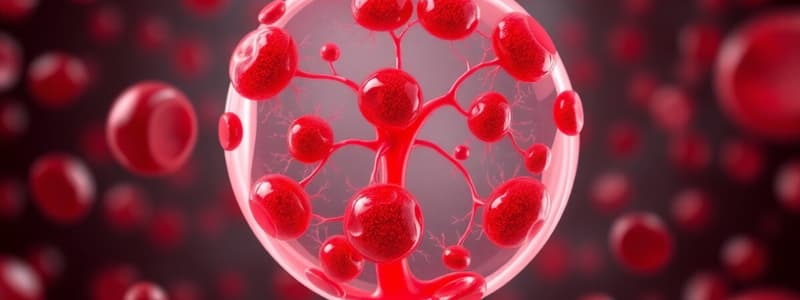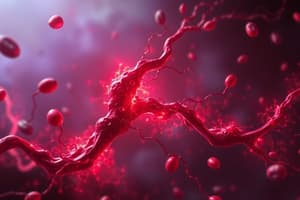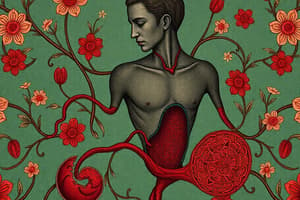Podcast
Questions and Answers
What blood type is considered the universal donor?
What blood type is considered the universal donor?
- Type O- (correct)
- Type AB
- Type A
- Type B
What condition can arise when an Rh-negative mother carries a second Rh-positive fetus?
What condition can arise when an Rh-negative mother carries a second Rh-positive fetus?
- Erythrocytosis
- Hemolytic disease of the newborn (HDN) (correct)
- Polycythemia vera
- Thrombocytopenia
Which statement is true regarding Rh factor compatibility?
Which statement is true regarding Rh factor compatibility?
- All Rh-negative individuals can receive Rh-positive blood without issues.
- Rh-negative blood is suitable for Rh-positive recipients. (correct)
- Rh-positive blood has no antigens.
- Rh-positive blood can be donated to Rh-negative recipients.
What is the primary use of whole blood transfusions?
What is the primary use of whole blood transfusions?
How long can blood be stored in blood banks?
How long can blood be stored in blood banks?
What condition is characterized by a clot that remains where it is formed?
What condition is characterized by a clot that remains where it is formed?
What is one primary function of blood in the human body?
What is one primary function of blood in the human body?
Which blood type can universally receive blood from any donor?
Which blood type can universally receive blood from any donor?
What reaction occurs when the antibodies in the plasma interact with incompatible blood type antigens?
What reaction occurs when the antibodies in the plasma interact with incompatible blood type antigens?
Which component of plasma makes up the majority of its composition?
Which component of plasma makes up the majority of its composition?
Which type of blood contains anti-A and anti-B antibodies in the plasma?
Which type of blood contains anti-A and anti-B antibodies in the plasma?
What is the pH range of blood, indicating its alkaline nature?
What is the pH range of blood, indicating its alkaline nature?
What is the primary consequence of a mismatch during a blood transfusion?
What is the primary consequence of a mismatch during a blood transfusion?
Which of the following formed elements is responsible for oxygen transport?
Which of the following formed elements is responsible for oxygen transport?
What type of antigens do red blood cells from a Type B individual contain?
What type of antigens do red blood cells from a Type B individual contain?
Which term describes the process that prevents excessive bleeding?
Which term describes the process that prevents excessive bleeding?
What is the risk of an embolus dislodging from its original site?
What is the risk of an embolus dislodging from its original site?
What is the primary role of leukocytes in the blood?
What is the primary role of leukocytes in the blood?
In which component of blood are antibodies primarily found?
In which component of blood are antibodies primarily found?
What can result from an abnormality in blood cell production or destruction?
What can result from an abnormality in blood cell production or destruction?
What is one potential consequence of Rh incompatibility?
What is one potential consequence of Rh incompatibility?
What is the primary cause of hemolytic anemia?
What is the primary cause of hemolytic anemia?
Which type of anemia is specifically associated with a deficiency of vitamin B12?
Which type of anemia is specifically associated with a deficiency of vitamin B12?
What is a characteristic of myelogenous leukemia?
What is a characteristic of myelogenous leukemia?
Which of the following disorders involves impaired blood coagulation?
Which of the following disorders involves impaired blood coagulation?
What does a complete blood count primarily assess?
What does a complete blood count primarily assess?
Which type of leukocyte is primarily responsible for combating bacterial infections?
Which type of leukocyte is primarily responsible for combating bacterial infections?
What is the primary function of hemoglobin in red blood cells?
What is the primary function of hemoglobin in red blood cells?
Where in the body are most blood cells produced?
Where in the body are most blood cells produced?
Which statement about erythrocytes is true?
Which statement about erythrocytes is true?
What role do basophils play in the immune response?
What role do basophils play in the immune response?
What primary function do platelets (thrombocytes) serve in the body?
What primary function do platelets (thrombocytes) serve in the body?
Which statement correctly describes agranulocytes?
Which statement correctly describes agranulocytes?
What does the term 'hemostasis' refer to?
What does the term 'hemostasis' refer to?
Which of the following is NOT a function of lymphocytes?
Which of the following is NOT a function of lymphocytes?
Which formed element of blood is known for not having a nucleus?
Which formed element of blood is known for not having a nucleus?
Flashcards
Blood function
Blood function
Blood transports oxygen, nutrients, and waste; regulates temperature and fluid balance; and protects against infection and bleeding.
Blood plasma composition
Blood plasma composition
Plasma is mostly water (91%) with dissolved substances like proteins (albumins, clotting factors, antibodies, complement) and waste products.
Blood formed elements
Blood formed elements
These are the cellular components of blood, including red blood cells (erythrocytes), white blood cells (leukocytes), and platelets.
Red Blood Cells (RBCs)
Red Blood Cells (RBCs)
Signup and view all the flashcards
White Blood Cells (WBCs)
White Blood Cells (WBCs)
Signup and view all the flashcards
Blood Volume
Blood Volume
Signup and view all the flashcards
Blood pH
Blood pH
Signup and view all the flashcards
Blood type
Blood type
Signup and view all the flashcards
What is a thrombus?
What is a thrombus?
Signup and view all the flashcards
What is thrombosis?
What is thrombosis?
Signup and view all the flashcards
What is an embolus?
What is an embolus?
Signup and view all the flashcards
What is an embolism?
What is an embolism?
Signup and view all the flashcards
What is an antigen?
What is an antigen?
Signup and view all the flashcards
What is an antibody?
What is an antibody?
Signup and view all the flashcards
What are blood types?
What are blood types?
Signup and view all the flashcards
What is the 'universal recipient' blood type?
What is the 'universal recipient' blood type?
Signup and view all the flashcards
Granulocytes
Granulocytes
Signup and view all the flashcards
Agranulocytes
Agranulocytes
Signup and view all the flashcards
Phagocytes
Phagocytes
Signup and view all the flashcards
Neutrophils
Neutrophils
Signup and view all the flashcards
Eosinophils
Eosinophils
Signup and view all the flashcards
Basophils
Basophils
Signup and view all the flashcards
Lymphocytes
Lymphocytes
Signup and view all the flashcards
Monocytes
Monocytes
Signup and view all the flashcards
Platelets
Platelets
Signup and view all the flashcards
Hemostasis
Hemostasis
Signup and view all the flashcards
Hemorrhagic Anemia
Hemorrhagic Anemia
Signup and view all the flashcards
Hemolytic Anemia
Hemolytic Anemia
Signup and view all the flashcards
Sickle Cell Anemia
Sickle Cell Anemia
Signup and view all the flashcards
Nutritional Anemia (Iron)
Nutritional Anemia (Iron)
Signup and view all the flashcards
Pernicious Anemia
Pernicious Anemia
Signup and view all the flashcards
Universal Donor
Universal Donor
Signup and view all the flashcards
Universal Recipient
Universal Recipient
Signup and view all the flashcards
Rh Factor in Pregnancy
Rh Factor in Pregnancy
Signup and view all the flashcards
Erythroblastosis Fetalis
Erythroblastosis Fetalis
Signup and view all the flashcards
Whole Blood Transfusions
Whole Blood Transfusions
Signup and view all the flashcards
Study Notes
Blood Functions
- Blood is fluid tissue containing dissolved chemicals and millions of cells.
- It's the primary transport fluid, responsible for pickup, delivery, and protection from invaders.
Blood Composition & Volume
- Blood is comprised of two main components: plasma and formed elements.
- Plasma, the liquid portion (extracellular), is roughly 55% of whole blood and mainly water (91%).
- Formed elements (cellular components) account for about 45% and consist of various cells (e.g., erythrocytes, leukocytes, platelets).
Blood Plasma
- Plasma (excluding formed elements) is primarily water (91%) with essential substances for cell survival.
- It contains proteins like albumins, clotting factors, antibodies, and complement.
- Waste products from cells travel through plasma to excretory organs.
Formed Elements
- Three main types: red blood cells (erythrocytes), white blood cells (leukocytes), and platelets (thrombocytes).
- Erythrocytes: responsible for oxygen and carbon dioxide transport, are biconcave disks, lack a nucleus and have hemoglobin.
- Leukocytes (white blood cells): defend against pathogens, have different types (granular: neutrophils, eosinophils, basophils; agranular: lymphocytes, monocytes).
- Platelets (thrombocytes): essential for blood clotting, lack nuclei and DNA.
Blood Cell Formation
- Blood cells are produced in red bone marrow (myeloid tissue) and lymphatic tissue (lymph nodes, thymus, and spleen).
- Hematopoietic stem cells are the parent cells of all blood cells, continuously divide and differentiate.
Hemoglobin
- Hemoglobin, located in red blood cells, transports oxygen and carbon dioxide.
- Plays a role in regulating the acid-base balance of the blood.
Blood Production Regulation
- Blood oxygen levels are monitored by the kidneys.
- When oxygen levels are low, the kidneys release erythropoietin, stimulating red blood cell production in bone marrow.
Types of White Blood Cells
-
Granulocytes: characterized by granules in their cytoplasm.
- Neutrophils are highly phagocytic; increase in bacterial infections.
- Eosinophils: defense against parasites.
- Basophils: release histamine and heparin, involved in allergic reactions.
-
Agranulocytes: lack granules in their cytoplasm.
- Lymphocytes: diverse immune actions involving T and B cells.
- Monocytes: differentiate into macrophages in tissues, performing phagocytosis.
Platelets and Blood Clotting
- Platelets are essential in blood clotting and play a vital role in the hemostasis process.
- Hemostasis is a three-stage process: vascular spasm, platelet plug formation, and coagulation.
Blood Clotting Steps
- Damage to a blood vessel causes the release of clotting factors.
- Platelets become sticky at the site and form a plug.
- Prothrombin activator leads to thrombin converting fibrinogen to fibrin, creating the blood clot.
Blood Disorders
- Anemia: low hemoglobin or a deficiency in red blood cells; causes include excessive loss or destruction of red blood cells or impairment in production (e.g., iron deficiency).
- Leukemia: an increase in immature white blood cells; often cancerous.
- Clotting disorders are characterized by excessive bleeding due to a disruption in the coagulation process. (e.g., hemophilia, von Willebrand disease)
Blood Types
- Blood type is determined by the presence or absence of specific antigens on red blood cells and corresponding antibodies in the plasma.
- ABO system: A, B, AB, and O types.
- Rh factor: Rh+ or Rh-. Rh incompatibility during pregnancy can cause erythroblastosis fetalis.
Blood Transfusions
- Rh-negative blood can be safely donated to Rh-positive recipients.
- Rh-positive blood cannot be donated to Rh-negative recipients, as the recipient's antibodies will attack the donor's blood.
- O- is the universal blood donor, and AB+ is the universal recipient (blood type).
Blood Studies
- Complete blood counts, hematocrit, blood smears, blood chemistry tests, coagulation studies, and bone marrow studies help diagnose various blood disorders.
Blood Use & Components
- Whole blood and blood components are used in transfusions to replace blood volume, treat circulatory failure or deficiencies, and to provide needed antibodies.
Studying That Suits You
Use AI to generate personalized quizzes and flashcards to suit your learning preferences.
Related Documents
Description
Explore the essential functions and components of human blood in this quiz. Learn about the roles of plasma and formed elements, as well as the makeup of this vital fluid. Test your knowledge on how blood facilitates transport and protection in the body.




